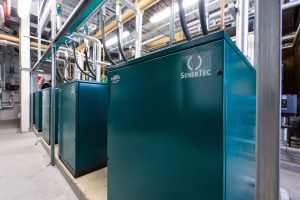
Combined heat and power (CHP) is becoming an increasingly popular option for public sector buildings, generating low-carbon energy on site. With the potential to reduce energy costs and achieve green targets, there’s no doubt CHP is worth the investment — but as with any new technology, forward planning is key if efficiencies are to be maximised, says Gary Stoddart.
Over the last few years, CHP has grown in popularity in the public sector, with building services engineers and managers taking inspiration from a growing bank of tried and tested examples where the technology has helped to save money and reduce carbon. CHP is around 30% more efficient than relying on traditional heating plant and electricity supplied solely from the grid — helping to reduce both gas and electric bills — and can be installed in a range of buildings, as long as there is a central plant room.
This could include schools, leisure centres and multiple-dwelling residential developments, with the latter becoming more attractive since the Government announced a budget of £300m for heat networks in December last year. These systems, which supply heating and hot water to multiple properties from a central plant room, are helping to improve the feasibility of installing commercial grade low-carbon technologies that wouldn’t normally be an option for individual properties. As a result, it is possible to entirely remove gas fuelled appliances from rented homes, simplifying requirements in terms of gas checks, delivering property management savings and ultimately bringing down fuel bills for tenants.
When it comes to designing an efficient heating system with CHP at its heart, it’s essential the unit is properly sized — but voltage optimisation and the Distribution Network Operator (DNO) application procedure must also be given adequate thought.
CHP efficiencies
Voltage optimisation is all about protecting the CHP unit and safeguarding cost efficiencies by regulating and optimising the electrical supply to the unit itself. As a result of energy supplies being harmonised across Europe in 1995 to 230 volts, and a bandwidth being placed on the voltage of plus or minus 10%, the electrical supply in the UK actually fluctuates between 207 and 253 volts. This can cause operational issues with everyday appliances like kettles and TVs, meaning that it can also impact on larger equipment, such as a CHP unit.
The good news is that the fluctuation can be managed through voltage optimisation — an energy saving technology that ensures a stable voltage is supplied at all times. It can achieve savings by ensuring the customer is only paying for the energy they use, and can also protect and prolong the life of the equipment by helping to guard against a shut-down caused by a drop in voltage.
As CHP is most efficient when it is running all the time, this approach can also maximise return on investment by ensuring that the unit is constantly generating power for local use.
Voltage optimisation is not a new concept; for a long time it has been incorporated into schemes to both maximise savings and safeguard the level of voltage fed to the system to prevent problems — but unfortunately it is not always considered during the planning stages of CHP installations.
Power factor
Another way to increase the efficiency of a CHP unit is by introducing power factor 
correction. The term ‘power factor’ is a measure of how efficiently electrical power is consumed. The desirable relationship between ‘real power’ and the ‘apparent power’ is one to one. Unfortunately, in the real world, power factor is reduced by highly inductive loads to 0.7 or less. Power factor correction is a method of reducing an electrical load, minimising wasted energy and hence improving the efficiency of plant and reducing electricity bills.
By using voltage optimisation and power factor correction, electrical consumption is reduced, the lifespan of electrical components is prolonged and an uninterrupted supply is delivered from the CHP installation. Electrical savings of between 4 and 20 % could be expected with voltage optimisation and/or power factor correction, and payback can be as soon as a year.
Plan of action
Forward planning is equally important when it comes to the DNO application procedure, which connects the CHP plant to the local electricity distribution network — a must for any generator. The procedure applies to three phase generation installations that are either rated above 16A (3.68kW) per phase, or that do not meet the requirements of the current version of the Energy Networks Association (ENA) document Engin
eering Recommendation G83/2. Where the G59 connection procedure applies, the installation must comply with ENA G59/3.
 Applications should be made to the local DNO as soon as possible after CHP has been specified, as approvals can take several months. However, some CHP units like the SenerTec Dachs Mini-CHP (5.5kW) comply with the requirements of ER G83/2, meaning that one or two units can be connected without seeking permission from the local DNO, with the application being made up to one month after the installation is complete. For three or more Dachs Mini-CHP units, ER G59/3 applies, requiring prior permission from the DNO.
Applications should be made to the local DNO as soon as possible after CHP has been specified, as approvals can take several months. However, some CHP units like the SenerTec Dachs Mini-CHP (5.5kW) comply with the requirements of ER G83/2, meaning that one or two units can be connected without seeking permission from the local DNO, with the application being made up to one month after the installation is complete. For three or more Dachs Mini-CHP units, ER G59/3 applies, requiring prior permission from the DNO.
SenerTec will guide specifiers through their voltage optimisation options and the DNO procedure as standard, giving assistance with the application paperwork and explaining all the steps to help ensure a smooth, hassle-free process.
Low-carbon technologies like CHP can pay dividends in the shape of carbon and cost savings, but like any heating system forward planning is key to maximising performance. By working closely with the CHP supplier, building service engineers and managers can be sure of getting the best out of their system, reducing energy and emissions for years to come.
Gary Stoddart is general manager of SenerTec








